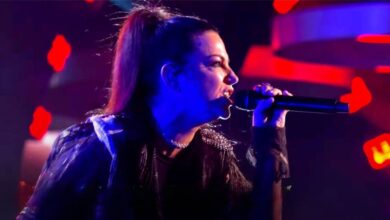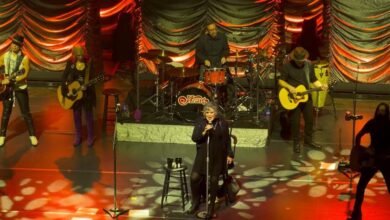Ann Wilson’s “Stairway to Heaven” at the Kennedy Center: The Night Rock Music Touched the Divine
On a winter night in Washington, D.C., the Kennedy Center Opera House became the unlikely setting for one of rock’s most cherished tributes. Led Zeppelin were being honored for their towering impact on American culture, and the evening had that mix of ceremony and electricity that only happens when history meets myth. In the balcony sat Robert Plant, Jimmy Page, and John Paul Jones, framed by television lights and the rainbow ribbons of the Honors. On the main stage, the house band tuned in low light as an orchestra settled and the audience hushed, not knowing they were minutes from witnessing a performance that would be replayed for years.
What followed was not a museum piece but a living, breathing act of translation. Ann and Nancy Wilson of Heart walked on with the quiet assurance of artists who know the weight of the song they are about to sing. They didn’t rush to the famous riff or announce themselves with pyrotechnics. Instead, they allowed the overture to settle like mist, each instrument finding its place. The mood was reverent but unafraid—less a reenactment than a conversation with the past, using the musical vocabulary they had spent a lifetime mastering.
The choice of Heart was inspired for reasons beyond the headline. Ann Wilson is one of the few rock singers with the range, color, and interpretive courage to tackle the Zeppelin canon without resorting to imitation, while Nancy Wilson’s rhythm work and arranging instincts can make even the most familiar progression feel new. Together they’ve long balanced power with poise, an equilibrium that “Stairway to Heaven” demands. They approached the song like a cathedral: enter softly, walk the aisles, then aim for the dome, where the echoes live.
As the first verses unfurled, the camera found Plant’s face—alert, wary, then gradually softened by recognition. Ann’s phrasing treated each line as a hinge, opening the door slightly wider to the next harmonic room. She sang with a mixture of restraint and inevitability, the consonants feathered so the melody could float, yet anchored by a breath control that never called attention to itself. Nancy’s acoustic figure kept the pulse steady, a lantern held at chest height through the song’s lyrical woods, illuminating images everyone knows but still wants to see again.
The arrangement grew like a tide. A subtle swell of strings entered, followed by brass in the middle distance—colors more felt than heard at first. Then the rhythm section stepped forward, and with it came a shift from recollection to revelation. Jason Bonham, wearing a bowler hat in homage to his father, took his place behind the kit. The gesture mattered: a nod to lineage without attempting to fill impossible shoes. When his sticks finally lifted, so did the room, as if the building itself remembered the weight of that surname and chose to rise.
By now, the dynamic plan was clear: start with intimacy, then layer in community. Backup singers appeared like witnesses to a rite, followed by a full choir marshaled by veteran choral director Joyce Garrett. The massed voices didn’t crowd the harmony so much as lift it, giving the piece the feeling of a public benediction. You could hear the architecture of the hall respond—hard surfaces warming to human sound—until the balcony seemed to vibrate in sympathy. This was never a simple cover; it was a civic chorus, a collective statement about what rock can be when many hands carry it.
The performance was equally theatrical and musical, and that balance is why it endures. Television often shrinks music; this time, the music expanded television. The directors knew where to look: Nancy’s right hand for time, Ann’s eyes for intention, Bonham’s cymbal for punctuation, Plant’s expression for meaning. The edit never chopped the song into sound bites; it breathed with the band as the tempo rose and the harmony thickened. Viewers at home could sense the hall’s shared heartbeat, a rare instance of broadcast craft amplifying, rather than diluting, a moment.
Then came the hinge everyone waits for—the passage where “Stairway” leaves the chapel and walks into the open air. Electric guitars bloomed, the choir surged, and the drum kit found its stride. Ann’s vibrato narrowed to a laser, then widened to a bell. The sound became three-dimensional: strings drafting under the guitars, brass flashing a herald’s call, voices stacking into a single organism. You could count the instruments, but it made more sense to count the sensations—lift, drive, flight. In the balcony, Plant’s features buckled into something both private and public: the shock of being honored by your own creation.
Context matters, and this context was stacked with symbolism. The nation’s highest cultural award, a White House reception, a broadcast to millions, an audience that included President Barack Obama—all for a band once treated as the unruly id of rock. The Honors are designed to canonize, but they can also humanize, and that is what Heart’s arrangement did. It took a song engraved into collective memory and showed that it still had blood in it, that it could still move new air in a new room and make the old authors feel surprise at their own legacy.
Another quiet triumph was the guitar chair. Shane Fontayne handled the famous solo not as a note-for-note museum label but as a respectful reading with present-tense urgency. His tone cut cleanly through the choral bloom, threading melody through mass without tearing the fabric. The solo’s arc—confident, lyrical, unsentimental—bridged generations onstage: the Wilsons’ Seattle-bred classicism, Fontayne’s British-American journeyman fluency, Bonham’s familial thunder, and Garrett’s Washington choir, a microcosm of the city’s own musical mosaic. In different hands, that many elements could have blurred; here, they fused.
When the last refrain crested, form and feeling dovetailed. The choir’s consonants snapped like banners in wind while Ann rode the top line with a kind of fearless grace. Bonham’s fills didn’t imitate—how could they?—but they conversed with memory, quoting the language without copying the handwriting. In the final measures, the cameras returned to the balcony. Plant’s eyes glistened, Page’s half-smile deepened into a full one, and Jones leaned forward as if to catch the final overtone as it left the stage. There was applause, yes, but also the stunned silence that arrives when a room needs an extra breath.
Rewatching the broadcast years later, the detail work still pops. You notice how Nancy places the opening arpeggios behind the beat, keeping the verse conversational. You notice how the choir waits to enter until the harmony needs a roof, not a floor. You notice the precise moment the cameras cut to Plant, not to mine a meme but to witness a human response. These are not accidents; they’re choices that honor the architecture of the composition and the mythology of the band without flattening either into cliché. The result feels inevitable only after you’ve seen it.
The emotional reaction wasn’t performative. Plant has spoken often about the burden and blessing of “Stairway to Heaven,” a song that both liberated and followed him. To see him moved in 2012 suggested less nostalgia and more recognition: the music had been entrusted to new stewards and returned, burnished. Reports the next day captured the ripple effect—headlines about tears, social feeds buzzing, and clips being shared at a velocity rare for a televised gala. For once, hyperbole struggled to catch up to the footage, which made its own argument in six luminous minutes.
Part of the legend comes from how the performance reframed the song’s spiritual question. “Stairway” often invites grandstanding; Heart chose consecration. The choir wasn’t mere garnish; it was dramaturgy, embodying the collective voice implied by the lyric’s search for meaning. In that hall, under those lights, the journey from whisper to roar felt less like a rock arrangement and more like liturgy, the congregation joining at the climactic “and as we wind on down the road.” Reverence can be risky in rock. This time it carried the room, precisely because it never tipped into preciousness.
The Honors also positioned Zeppelin alongside artists outside rock—Buddy Guy, Dustin Hoffman, David Letterman, Natalia Makarova—reminding viewers that cultural influence wears many costumes. The tribute program mapped a lineage instead of a silo, connecting blues to hard rock, stage to screen, comedy to catharsis. As the closing number, “Stairway” functioned like a thesis statement: popular art can be both technically exacting and widely loved; it can start as a private spark and end as a communal fire. That message, delivered by Heart, landed with rare clarity that night.
The aftermath was swift. Clips sailed around the world; radio shows replayed the audio; think pieces proliferated about covers that transcend imitation. Heart’s version even hit digital platforms, where listeners heard what the cameras couldn’t show: the bowler hats, the swelling choir, the visible affection between performers and honorees. Yet the audio carried enough to make new fans go hunting for the video, proof that the arrangement’s bones were strong, that the performance wasn’t just a visual confection but a musical argument with its own internal logic.
More than a decade on, the performance has matured into folklore. New listeners encounter it as a recommended clip and fall into the same silent awe that gripped the Opera House. Singers study Ann’s vowel shapes and breath strategy; drummers parse Bonham’s choices for echoes of his father without mimicry; arrangers note how and when to deploy massed voices. Most tributes flatter the original. This one conversed with it, then sent it back upstairs with something added: gratitude made audible. That’s why the footage endures—not as a relic, but as a continuing invitation to believe in scale.
Perhaps the finest measure of its success is that it feels both inevitable and unrepeatable. Of course Heart should sing “Stairway” at the Kennedy Center; of course Jason Bonham should sit at the kit; of course a D.C. choir should lift the final chorus into the rafters. But that “of course” exists only because lightning struck. Any one element slightly off—tempo, camera, voicing, ego—could have spoiled the alchemy. Instead, everything aligned. For six minutes, classic rock’s most sacred space was not a vinyl groove or a memory but a room, and everyone in it knew they were standing on holy ground.





